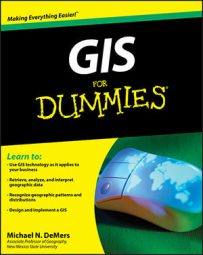With GIS (geographic information system) you can do all sorts of geography-related stuff — find places, of course, but also find the best place to locate your business, among other things. The following list summarizes some of the tasks you can accomplish with GIS:
Find geographic features. You can search a GIS database to find point, line, area, and surface features by their descriptions or measurements.
Measure geographic features. You can measure lengths, widths, areas, and volumes, and compare sizes from one feature to another.
Characterize distributions. You can group geographic features and define their distributions based on how much space they use, how close they are to each other, and where they are relative to other features.
Summarize geographic data. You can calculate all sorts of statistics on your geographic features from the simplest descriptive statistics (for example, mean, median, and mode) to very complex spatial statistics.
Work with networks. You can find routes based on time, distance, or other factors. You can route buses to reach the maximum number of people and use this population density information to locate stores near your customers.
Compare map layers. You can compare the locations of features from one map layer (or theme) to another. This powerful feature helps you overlay the layers, and shows you the relative location of features from one layer to another.
Perform surface analysis. You can work on the many surfaces available in GIS and use mathematical methods (such as interpolation) to find missing values and perform other analyses.

